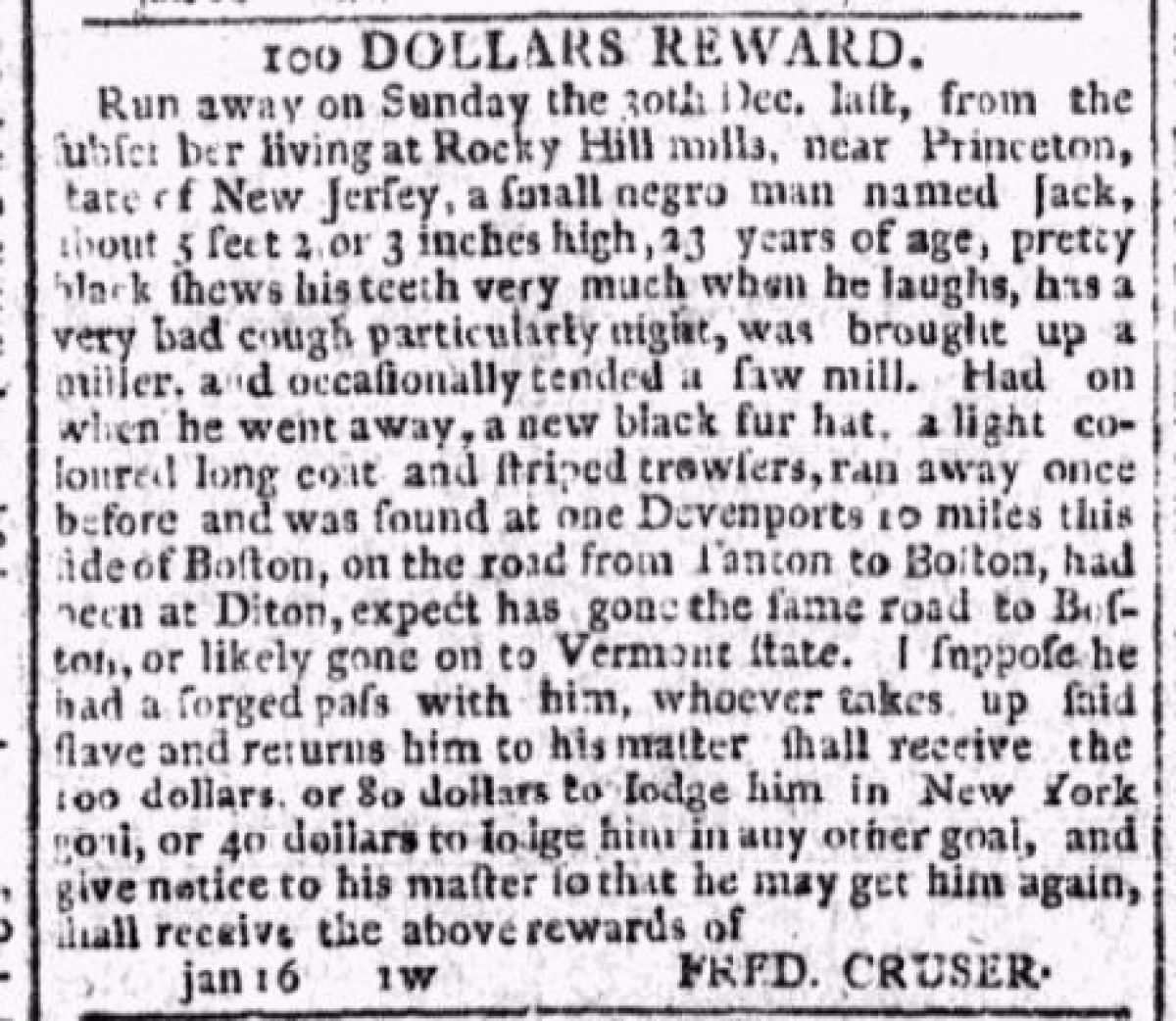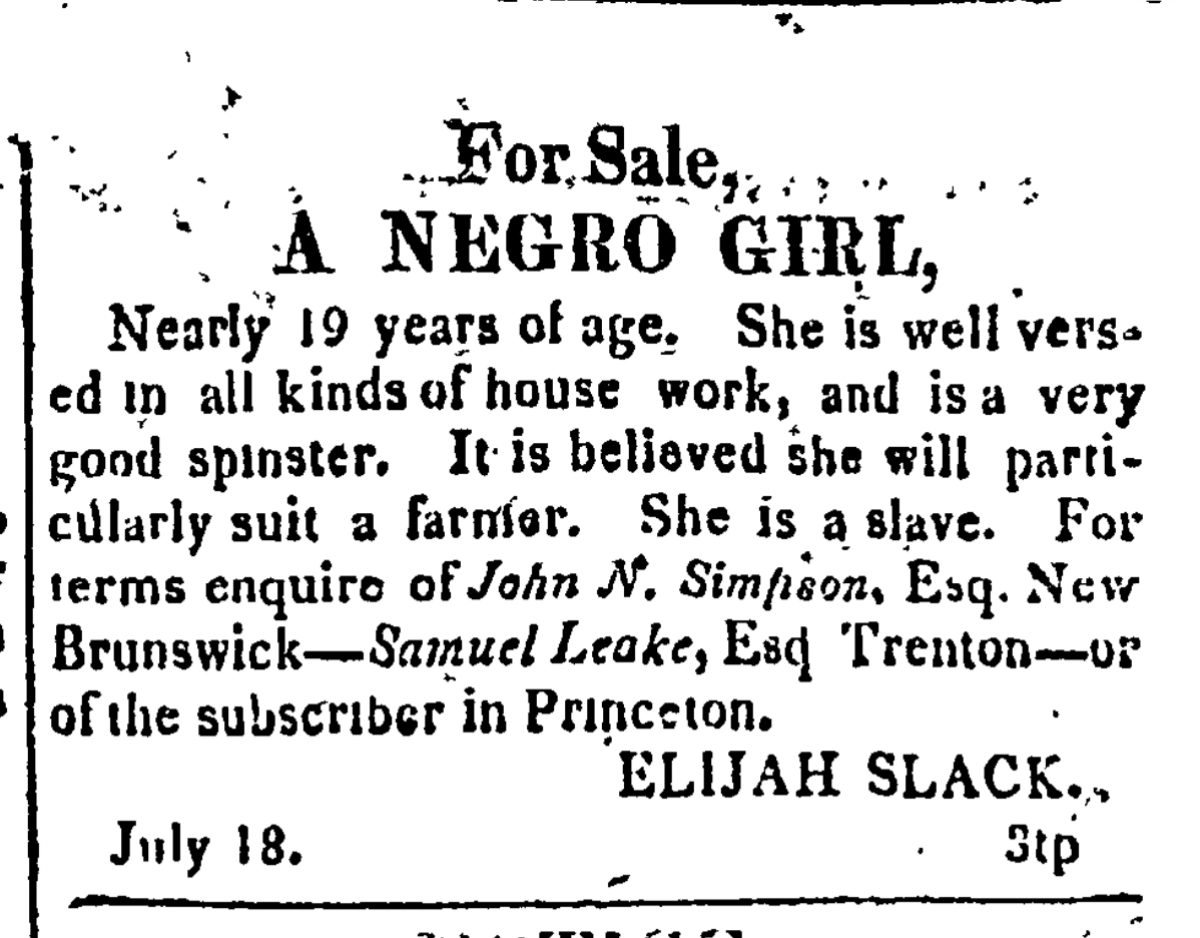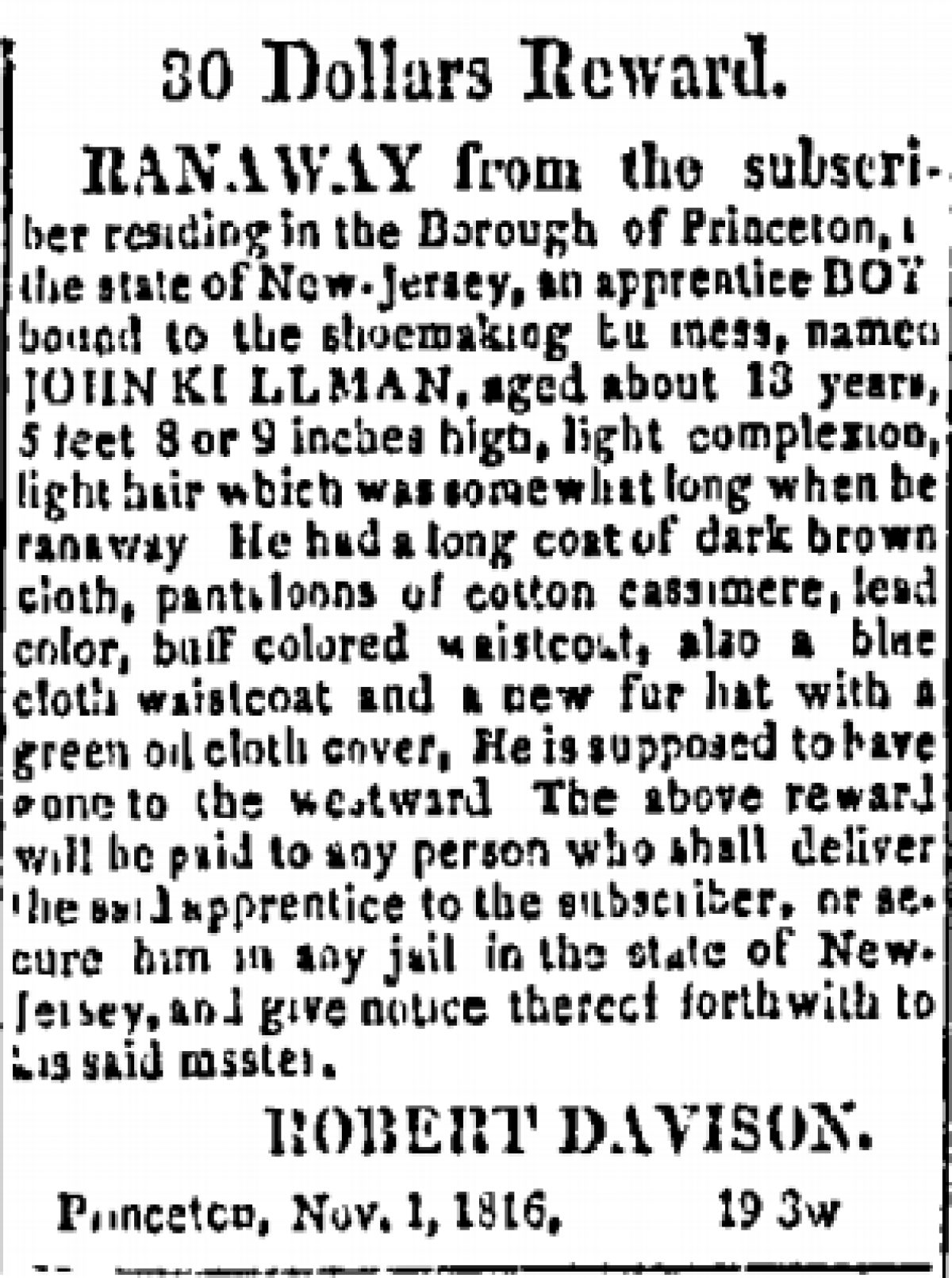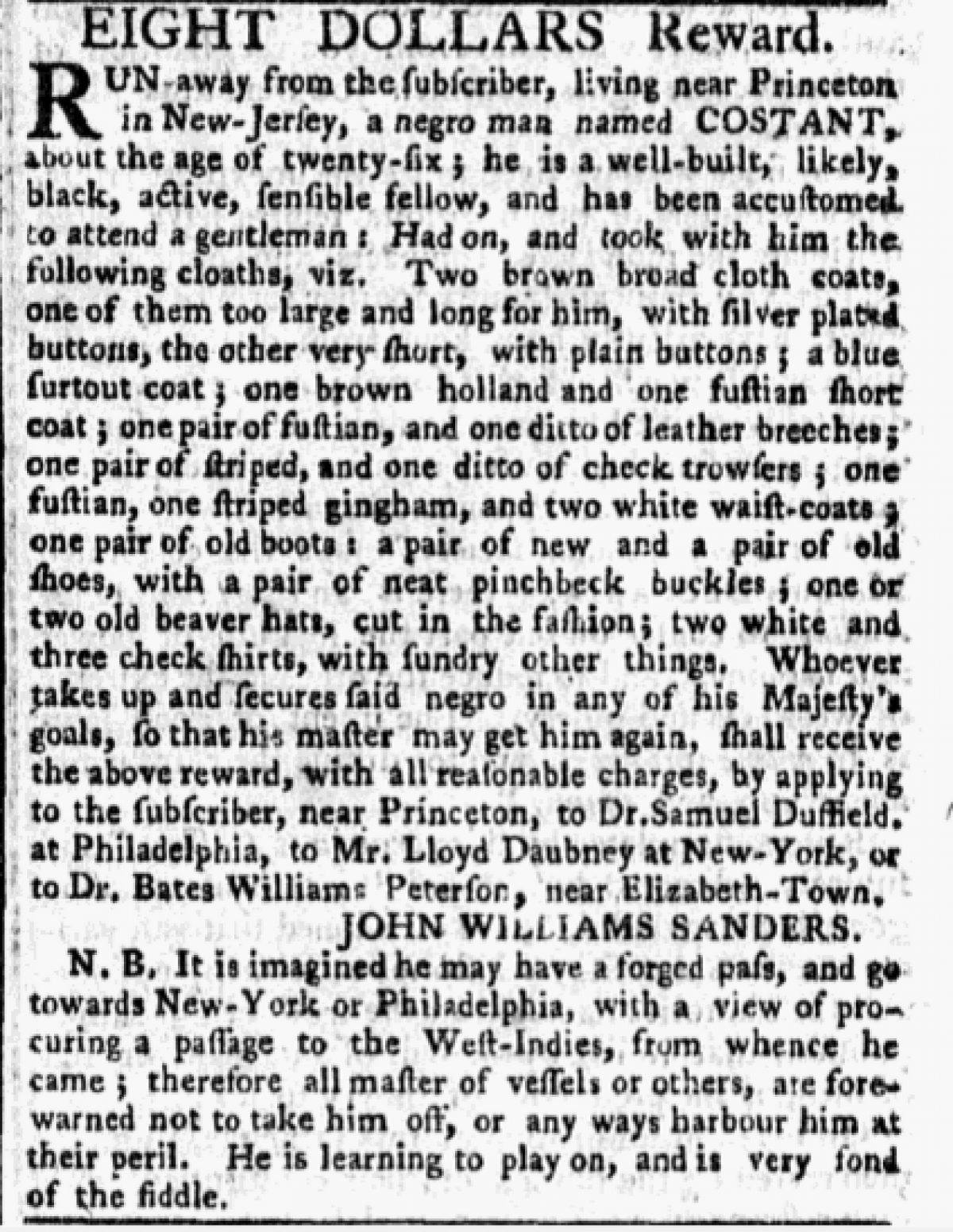$100 Reward
On Sunday December 30, 1798, an enslaved man named Jack ran away from Fred Cruser’s property of Rocky Hill Mills near Princeton, New Jersey. Cruser published a notice in the Daily Advertiser of New York a few weeks later, offering a substantial “100 Dollars Reward” for the capture and return of his slave. According to Cruser, Jack was 23 years old at the time, a “pretty black” man about “5 feet 2 or 3 inches high.”[1] He escaped wearing a new black fur hat, a light-colored long coat, and striped trousers. Moreover, the runaway could be identified by his particular way of laughing, showing his “teeth very much.” He also had a “very bad cough particularly at night.” One can imagine that daily work in the sawmill took a toll on Jack’s health.
This was Jack’s second escape attempt. The first time, he managed to reach the town of “Devenports, 10 miles this side of Boston” before being recaptured—a journey of more than 250 miles that demonstrated the young man’s determination.[2] This time he chose to flee in late December, deep into the New Jersey winter, willing to face extreme weather in an attempt to be free.
Fred Cruser reckoned that Jack would travel a similar route to the one he took before: either to the metropolitan center of Boston, Massachusetts, where slaves could more easily seek manumission through the courts, or to distant Vermont, which had abolished slavery in 1777.[3] On his journey, however, Jack would have to travel through mid-Atlantic states like New Jersey and New York, where slavery remained legal. To escape detection he carried a “forged pass.”[4] He’d planned his escape well.
Fred Cruser’s notice is one of 33 fugitive slave ads published between 1770 and 1819 in the greater Princeton area.[5] The advertisements illustrate the ways in which enslaved people like Jack took advantage of the late-18th century’s changing landscape of slavery. After the American Revolution, states across the Northeast would pass a number of laws addressing slavery, most of them gradual emancipation acts that freed enslaved people after a period of years.[6] Following the examples of Vermont, Massachusetts, Connecticut, Rhode Island, and the neighboring states of New York and Pennsylvania, New Jersey became the last northern state to pass a gradual emancipation act in 1804.
In their escape attempts, enslaved people demonstrated their awareness of the era’s legal and political landscape—a fact that slave-owners tacitly acknowledged in their advertisements, which speculated about runaways’ destinations and motives. Princeton’s runaways, self-liberating men and women, drew on kinship bonds and a sophisticated knowledge of the world around them to plan their escapes, fleeing to free or almost-free states and port cities. While their masters expected enslaved people to make calculated decisions in the pursuit self-liberation, they were also at a loss how to reassert control.
Patterns of Escape
As evident in diaries, slave auction notices, and escape ads, enslaved people played important roles in farming, commercial, and domestic work in Princeton.[7] For example, the fugitive Elsy Murray, a slave of Peter Bogart (the steward of the Princeton Theological Seminary) was literate and an “excellent house wench.”[8]
A “Negro Girl” owned by Princeton University Vice President Elijah Slack in 1812 was advertised as being “well-versed in all kinds of house work, and a very good spinster.”[9]
Enslaved men, by contrast, tended to perform agricultural work on farms owned by the town’s elite. Father and son Bristol and Abram, part of an enslaved family owned by Colonel Erkuries Beatty (Princeton’s first mayor), broke and dried flax seed in the winter while likely planting wheat in the summer season.[10] There were at least 16 multi-generational slaveholding households in Princeton in the early 19th century.[11] These households clustered around large agricultural estates (Castle Howard Farm, the Walter Lowrie House, and Prospect Farm) as well as in the center of town.
According to local and regional newspapers, between 1770 and 1819 at least 34 enslaved people fled the small town of Princeton, with escapes peaking between 1795 and 1799. Not coincidentally, this was a time of increasing antislavery agitation in New Jersey and the mid-Atlantic region more broadly. Quakers connected to a “national coalition against slavery,” for example, pressured the New Jersey legislature to abolish enslaved labor.[12] Meanwhile, New York passed its gradual emancipation law in 1799.[13]
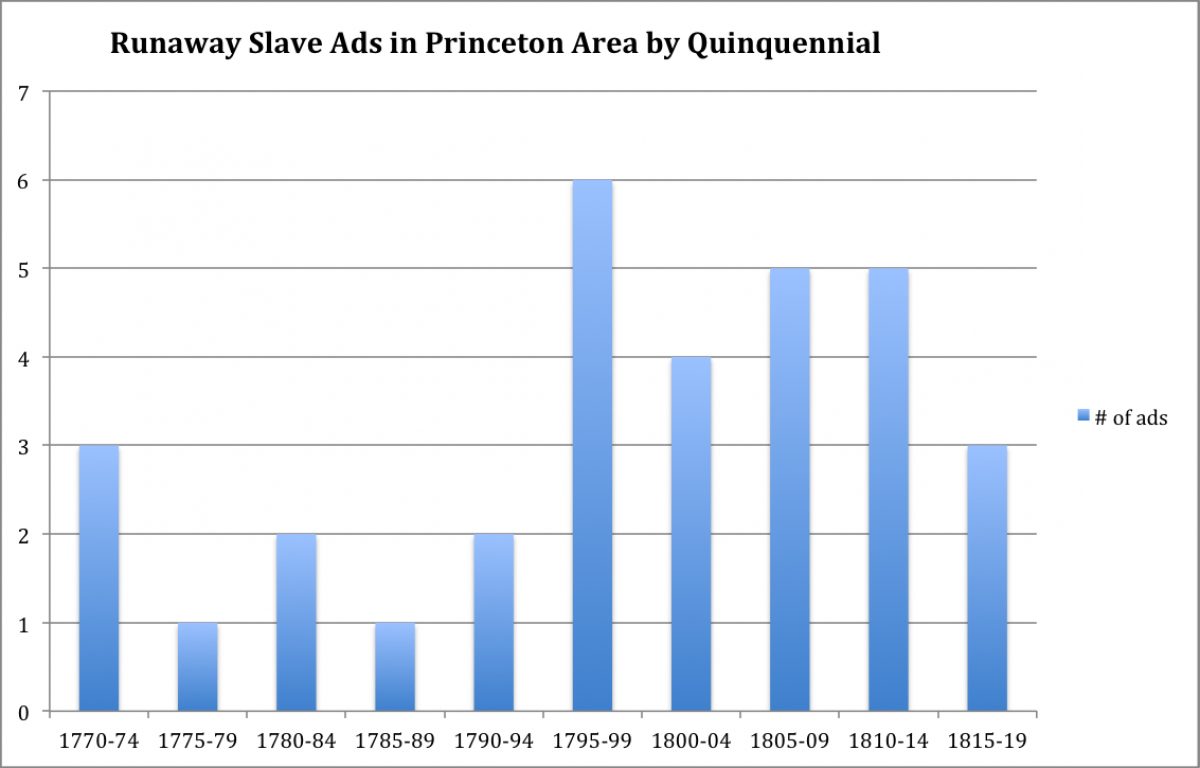
Graph showing the number of runaway slave ads published in the greater Princeton area between 1770 and 1819.
View Primary Sources
Located between Philadelphia and New York City, Princeton became an important stop for fugitive slaves fleeing southern states. Two “Underground Railroad” stations may have been located in Princeton during the early 19th century: one of them at the Monteith House at 344 Nassau Street, and the other across the street “in an unnamed house.”[14] Members of Princeton’s free black community risked their lives to shelter fugitives. According to an abolitionist newspaper, local black caterer John Anthony Simmons offered his home as a “resting place” for runaways during the 19th century.[15]
Interestingly, the largest number of attempted escapes from Princeton took place in April and November—the beginning of planting and harvesting seasons.[16] Perhaps this uptick indicates that escapes were timed to avoid the increased labor demands during these periods. Alternatively, climate may have played a role. April would have given runaways mild weather. Though colder, November provided another distinct advantage: slave catchers may have had a harder time tracking fugitives when days were shorter.
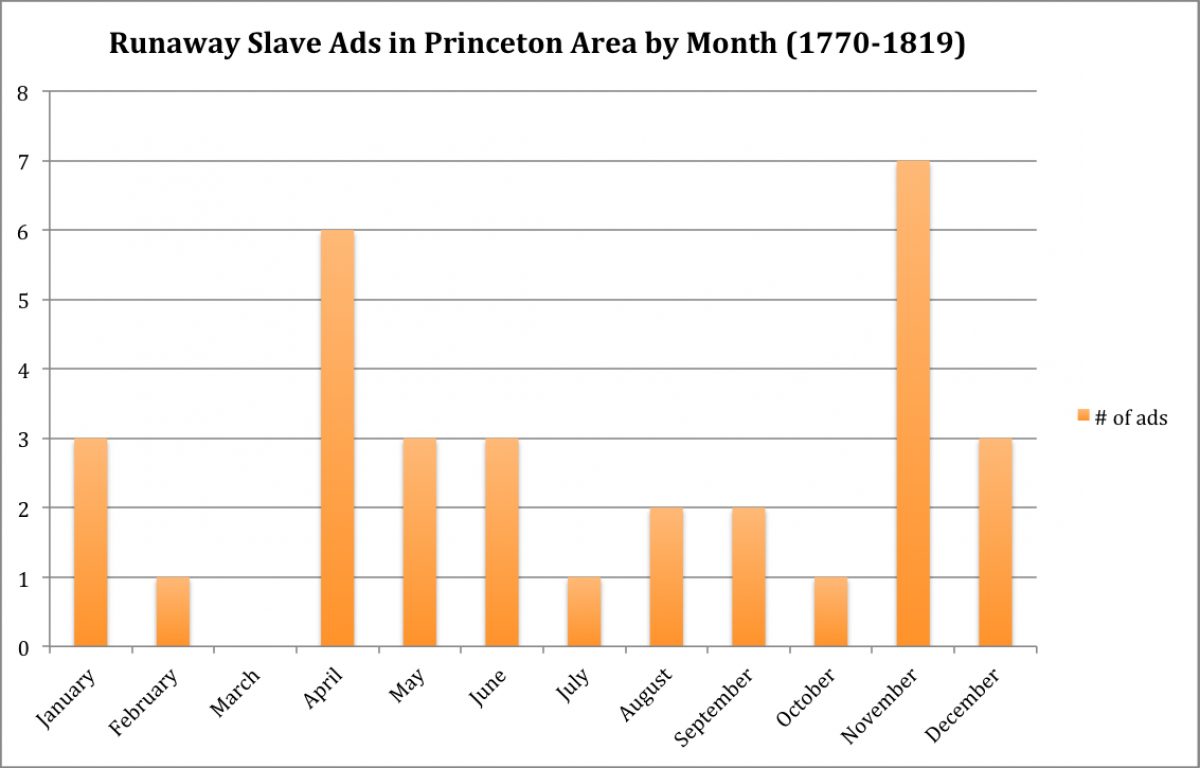
Graph showing the number of runaway slave ads published in the greater Princeton area between 1770 and 1819, by month.
View Primary Sources
Many fugitives were well prepared for their journeys, furnished with appropriate supplies, clothing, and forged passes. In 1816, 13-year-old John Killman, an “apprentice BOY” bound to a shoemaker until he turned 25 (according to New Jersey's gradual emancipation law), fled with a “long coat of dark brown cloth” and “a new fur hat with a green oil cloth cover”—both of which would have kept him warm and dry when he fled in early November.[17]
Routes and Destinations
In 11 of the 33 fugitive slave ads, slaveholders speculated about the possible routes and final destinations of the runaways. They did so on the basis of two main factors: their knowledge of enslaved people’s kinship ties and their sense of the shifting geographies of slavery and freedom in the United States. The ads reveal that slaveholders expected enslaved people would try to reach free states or cities with large free black populations, a tacit recognition of their human property’s knowledge of the political landscape.
Enslaved people sought help from family members. Runaways were thought to rely on relatives in nearby areas to take them in or to aid them on the next leg of their journeys. In February 1818, the “intelligent” 20-year-old Elsy Murray took advantage of her two-day travel pass to escape.[18] In The Fredonian, Elsy’s master speculated about her supposed whereabouts:
She is believed to be in the neighborhood of Piscataway, as she has a brother living in that quarter.
Some runaways were motivated by a desire to be with their spouses. Consider Lindor, a 30-year-old enslaved man who spoke “broken English” and was identifiable by a “little deformity in one of his thumbs.”[19] In 1802, Lindor absconded with an 18-year-old “young mulatto girl” to whom he was married but who lived apart from him in a household in Rocky Hill.[20]
Others were willing to travel incredible distances in order to be reunited with families from whom they had been separated by sale. When a 26-year-old “negro man” named Constant fled John William Sanders’s property with a forged pass in 1774, Sanders wrote:
It is imagined that he may have a forged pass, and go towards New-York or Philadelphia, with a view of procuring a passage to the West Indies, from whence he came.[21]
Although Constant had not been born in North America, Sanders clearly feared that he was knowledgeable enough to escape successfully and perhaps even reach the West Indies. He described the fugitive as “a well-built, likely, black, active, sensible fellow” who “has been accustomed to attend a gentleman” and could play the violin. Constant also took five coats, “two old beaver hats,” three pairs of shoes, and “sundry other things” when he ran away. “Therefore all master of vessels,” Sanders wrote, “are forewarned not to take him off, or any ways harbor him at their peril.”
Constant fled North America before Independence, and three years before the first law abolishing slavery would be passed in Vermont. In the following decades, however, advertisements would speak to the emerging reality of free states on the continent as well as the proliferation of kinship networks and support systems among United States-born slaves.
In June of 1791, Charity Miller of Stony Brook, New Jersey posted an advertisement for the capture and return of “a stout hearty fellow” with a “light complexion, heavy eyes, and [an] unpleasant countenance, fond of spirituous liquors” who went by the name of Jack.[22] “It is conjectured [that] he had gone into the state of Pennsylvania,” Miller announced in The Independent Gazetteer. In 1780, Pennsylvania had passed an act for the gradual abolition of slavery.[23] By the time Jack ran away, 63 percent of Pennsylvania’s black population was free and free black communities in the city harbored and aided runaways from nearby states.[24] Only 12 miles southeast of Princeton, Pennsylvania would have been a promising destination for runaways.
According to slaveholders’ speculations, another plausible destination for Princeton-area slaves was the port city of Baltimore. Even though Maryland was a slave state, it had the largest free black population of any state in the antebellum United States, and the prospect of belonging to (and disappearing into) a vibrant free community motivated many slaves to escape to Baltimore.[25]
New Jersey slaveholders like Captain John Schenck were concerned about Baltimore’s attractiveness to runaways. In an ad published on April 29, 1795, Schenck offered a 60 dollar reward for the capture of “two negro men.”[26] 20-year-old Jim, who was “a little lame on one of his feet” and had a “small bump on the outside of his foot,” had escaped with 19-year-old Sam. According to Schenck, the fugitives had been “traced from Trenton to Philadelphia,” where they were “supposed to be lurking [...] or [had] gone towards Baltimore.”
Conclusion
As plausible destinations for runaway slaves increased in the mid-Atlantic and Northeast during the late 18th and early 19th centuries, fugitive slave ads revealed how much both slaves and slaveholders were attuned to changing legal and political geographies marked by gradual abolition. Princeton slaves likely deliberated over what routes to take, which cities and states to run to, and which free communities to join. They would have been informed by rumors circulating among free blacks and within enslaved communities as well as precious information spread by abolitionist publications. Some literate slaves, like Elsy Murray, could have read newspapers and passed information along to other enslaved people.
Meanwhile, slaveholders’ speculations about escape routes and destinations were shaped by knowledge of their slaves’ strategic thinking. Princeton slaveholders often imagined that runaway slaves would seek refuge in Vermont or in the "freer" states of Massachusetts, New York, and Pennsylvania, as well as in port cities with large free black populations such as Baltimore, Philadelphia, and New York City.
The fact that slaveholders expected enslaved people to make calculated decisions about their escapes shows how runaways forced masters to acknowledge their resourcefulness and determination to liberate themselves. Eager to have their profitable property back, slaveholders reduced fugitives to a set of characteristics—a peculiar laugh, “a very bad cough,” an “unpleasant countenance,” “broken English,” a crippled foot, a crooked thumb, and shades of skin color—that supposedly made the fugitives easier to detect. These descriptions were dehumanizing in their own right. But they could not hide slaveholders’ implicit recognition of their slaves’ agency. The advertisements also suggest a weakening system of control: Princeton masters were increasingly at a loss as to where the people they wanted to think of as property would escape to next.
Bibliography
I want to thank the teachers of the Social Studies Department at Princeton High School, especially Dr. Rick Miller for his insightful and dedicated mentorship. I also want to thank Princeton Professor Martha Sandweiss for her encouragement and Isabela Morales for her thoughtful comments and valuable suggestions. I am grateful to Dr. Miqueias Mugge for his wonderful support.
References
[1]
“100 Dollars Reward,” Daily Advertiser, 16 January 1799.
⤴
[3]
Arthur Zilversmit, The First Emancipation: The Abolition of Slavery in the North (Chicago: University of Chicago Press, 1967), 114.
⤴
[4]
“100 Dollars Reward,” Daily Advertiser, 16 January 1799.
⤴
[5]
Using the America’s Historical Newspapers Database, I found slave ads in the following local and regional publications: Aurora General Advertiser, Brunswick Gazette, Daily Advertiser, Evening Post, Independent Gazetteer, New Brunswick Advertiser, New Jersey State Gazette, Pennsylvania Gazette, Pennsylvania Journal, Tickler, Trenton Federalist, True American, Daily Advertiser, Fredonian, Royal Gazette, New York Gazette, and Political Intelligencer. Source: America’s Historical Newspapers Database. Additional ads were found through Princeton and Slavery Project resources. My database of 33 fugitive slave ads can be accessed at https://www.slaveryinprinceton.com/database.html. For more information about the process of analyzing fugitive slave ads, see “Rediscovering the Stories of Self-Liberating People,” Freedom on the Move, accessed 29 January 2019, https://app.freedomonthemove.org/; Danny Lewis, “An Archive of Fugitive Slave Ads Sheds New Light on Lost Histories,” Smithsonian.com, 25 May 2016, accessed 29 January 2019, https://www.smithsonianmag.com/smart-news/archive-fugitive-slave-ads-could-shed-new-light-lost-histories-180959194/.
⤴
[6]
See James J. Gigantino II, The Ragged Road to Abolition: Slavery and Freedom in New Jersey, 1775-1865 (Philadelphia: University of Pennsylvania Press, 2016).
⤴
[7]
For example, see Colonel Erkuries Beatty’s diary in Harry B. Weiss and Grace M. Ziegler, Colonel Erkuries Beatty, 1759-1823 (Trenton, NJ: The Past Times Press, 1958).
⤴
[8]
“Twenty Dollars Reward,” The Fredonian, 14 May 1818.
⤴
[9]
“For Sale, A Negro Girl,” True American, 15 July 1816.
⤴
[10]
See Timothy Hack, “Janus-Faced: Post-Revolutionary Slavery in East and West Jersey, 1784-1804,” New Jersey History, Vol. 127, No. 1 (2012), 6; Weiss and Ziegler, Colonel Erkuries Beatty, 37.
⤴
[12]
James Gigantino describes this “expansion of manumission” as “critical to hundreds of West Jersey blacks who used this viable legal avenue of freedom to achieve what they had strived for since the Revolution.” Gigantino II, The Ragged Road to Abolition, 72-73.
⤴
[14]
William Switala, Underground Railroad in New York and New Jersey (Mechanicsburg, PA: Stackpole Books, 2006), 64-67.
⤴
[15]
“Died,” The Elevator, 20 March 1868.
⤴
[16]
During the late 18th and early 19th century, Somerset County and Princeton farms primarily produced fruits and grains. Weiss and Ziegler, Colonel Erkuries Beatty, 37.
⤴
[17]
“30 Dollars Reward,” True American, 25 November 1816.
⤴
[18]
“Twenty Dollars Reward,” The Fredonian, 14 May 1818.
⤴
[19]
“Ten Dollars Reward,” Trenton Federalist, 27 April 1802.
⤴
[21]
"Eight Dollars Reward," New York Gazette, 11 July 1774.
⤴
[22]
“Eight Dollars Reward,” Independent Gazetteer, 25 June 1791.
⤴
[23]
“An Act for the Gradual Abolition of Slavery” in The Statutes at Large of Pennsylvania (Philadelphia: Wm. Stanley Ray, 1904), 67.
⤴
[24]
See Ira Berlin, Generations of Captivity: A History of African-American Slaves (Cambridge, MA: Harvard University Press: 2003), 276.
⤴
[25]
Christopher Phillips, Freedom's Port: The African American Community of Baltimore, 1790-1860 (Urbana, IL: University of Illinois Press, 1997), 235.
⤴
[26]
“Sixty Dollars Reward,” Daily Advertiser, 29 April 1795.
⤴




